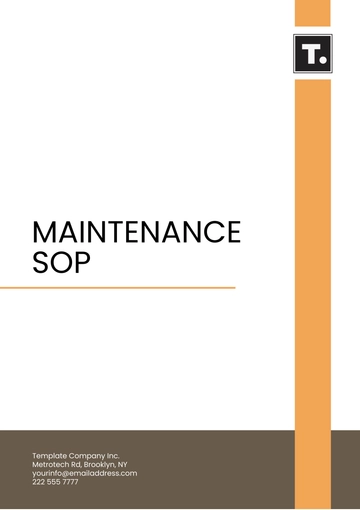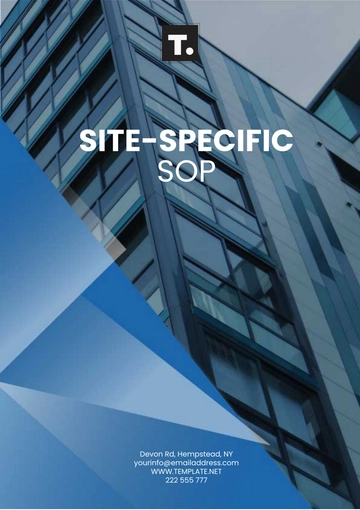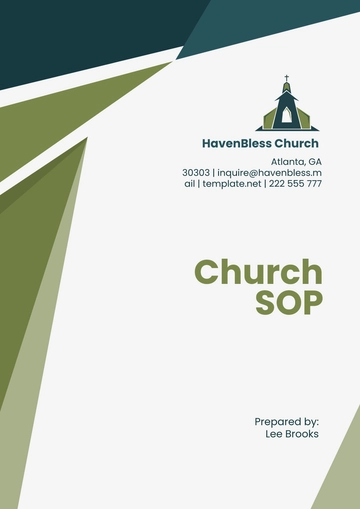Free Car Rental Finance SOP

1. Introduction
This Standard Operating Procedure (SOP) outlines the financial processes and protocols for [Your Company Name]. It serves as a comprehensive guide to managing financial operations, ensuring accuracy, compliance, and efficiency in all financial activities. This SOP aims to provide clear guidelines to enhance financial decision-making and maintain financial stability.
2. Purpose
The purpose of this Standard Operating Procedure (SOP) is multifaceted, aiming to provide a robust framework that enhances the financial operations of [Your Company Name]. A well-defined SOP is crucial for maintaining consistency, accuracy, and compliance in all financial activities. Below, we delve into each specific objective of this SOP and its importance to the organization.
Standardize Financial Processes Across the Organization
Standardizing financial processes ensures that every department within [Your Company Name] follows the same procedures and protocols. This uniformity is essential for several reasons:
Consistency: Standardized processes ensure that financial activities are conducted uniformly across the organization, reducing variability and the potential for errors.
Efficiency: Streamlined processes eliminate redundancies and optimize resource use, saving time and reducing costs.
Quality Control: Uniform procedures facilitate the identification and correction of errors, ensuring higher quality and accuracy in financial reporting.
Training and Onboarding: New employees can be trained more effectively with a standardized set of procedures, reducing the learning curve and ensuring consistency in financial practices.
Ensure Compliance with Financial Regulations and Standards
Compliance with financial regulations and standards is not just a legal obligation but also a cornerstone of ethical business practices. This SOP aims to ensure that [Your Company Name] adheres to all relevant financial regulations, including:
Local, State, and Federal Regulations: Ensuring compliance with all applicable laws and regulations to avoid legal penalties and fines.
Industry Standards: Adhering to best practices and standards set by industry bodies and associations to maintain credibility and trust.
Internal Policies: Following internal policies and guidelines designed to safeguard the company’s financial health and integrity.
Compliance ensures that the company operates within the legal framework, protecting it from potential legal and financial repercussions. It also builds trust with stakeholders, including investors, customers, and regulatory bodies, by demonstrating a commitment to ethical and transparent financial practices.
Improve the Accuracy and Efficiency of Financial Reporting
Accurate and efficient financial reporting is critical for decision-making and maintaining stakeholder confidence. This SOP aims to enhance financial reporting by:
Establishing Clear Reporting Guidelines: Providing detailed instructions on how to prepare and present financial reports.
Implementing Checks and Balances: Introducing internal controls to verify the accuracy of financial data and reports.
Automating Reporting Processes: Utilizing financial software and tools to automate data collection and reporting, reducing the risk of human error.
Regular Reviews and Audits: Conducting periodic reviews and audits to ensure the integrity of financial reports and identify areas for improvement.
Improved financial reporting enables [Your Company Name] to make informed decisions based on accurate and timely financial information. It also enhances transparency and accountability, fostering trust among stakeholders.
Enhance Financial Planning and Budgeting
Effective financial planning and budgeting are essential for the long-term success of [Your Company Name]. This SOP aims to improve these processes by:
Setting Clear Financial Goals: Establishing specific, measurable, achievable, relevant, and time-bound (SMART) financial objectives.
Developing Detailed Budgets: Creating comprehensive budgets that outline expected revenues, expenses, and resource allocations.
Regular Monitoring and Adjustments: Continuously monitoring financial performance against budgets and making necessary adjustments to stay on track.
Engaging Stakeholders: Involving key stakeholders in the planning and budgeting process to ensure alignment with the company’s strategic goals.
Enhanced financial planning and budgeting enable the company to allocate resources effectively, anticipate financial challenges, and seize growth opportunities. It provides a roadmap for achieving financial objectives and ensures that the company remains financially viable.
Manage Financial Risks Effectively
Financial risk management is crucial for safeguarding the company’s assets and ensuring long-term stability. This SOP outlines strategies for:
Identifying Risks: Conducting regular risk assessments to identify potential financial risks, such as market volatility, credit risk, and operational risks.
Assessing Risks: Evaluating the likelihood and impact of identified risks to prioritize mitigation efforts.
Mitigating Risks: Implementing strategies to reduce or eliminate risks, such as diversifying revenue streams, maintaining adequate liquidity, and securing appropriate insurance coverage.
Monitoring and Reviewing Risks: Continuously monitoring risk factors and reviewing risk management strategies to adapt to changing conditions.
Effective risk management protects [Your Company Name] from potential financial losses and ensures that the company can navigate uncertainties and challenges with resilience.
Provide a Clear Framework for Financial Decision-Making
A clear framework for financial decision-making is essential for ensuring that all financial actions align with the company’s strategic goals and ethical standards. This SOP aims to:
Establish Decision-Making Protocols: Define clear protocols for financial decision-making, including who is authorized to make decisions and what criteria must be considered.
Implement Internal Controls: Introduce checks and balances to ensure that financial decisions are made transparently and responsibly.
Encourage Data-Driven Decisions: Promote the use of accurate financial data and analysis in decision-making to ensure that decisions are based on sound evidence.
Foster Collaboration: Encourage collaboration among departments and stakeholders to ensure that financial decisions are well-informed and aligned with the company’s overall strategy.
Providing a clear framework for financial decision-making ensures that [Your Company Name] operates efficiently and ethically, with decisions that support the company’s growth and sustainability.
The purpose of this SOP is to establish a robust financial framework that enhances the overall financial health of [Your Company Name]. By standardizing processes, ensuring compliance, improving reporting, enhancing planning and budgeting, managing risks, and providing a clear decision-making framework, this SOP aims to support the company’s strategic objectives and foster long-term financial stability. This comprehensive approach to financial management will enable [Your Company Name] to navigate the complexities of the financial landscape, capitalize on opportunities, and achieve sustained success.
3. Scope
This SOP applies to all financial activities within [Your Company Name], including budgeting, revenue management, expense management, cash flow management, financial reporting, auditing, and compliance. It is applicable to all employees involved in financial operations, including finance managers, accountants, and auditors.
4. Roles and Responsibilities
A clear delineation of roles and responsibilities is essential for maintaining effective financial management within [Your Company Name]. This chapter outlines the specific duties of each key position involved in financial operations, ensuring accountability, clarity, and efficiency. By defining these roles, we aim to foster a well-coordinated approach to managing the company's financial activities.
Finance Manager:
Oversee all financial activities.
Ensure compliance with financial regulations.
Review and approve budgets and financial reports.
Manage financial risks.
Accountants:
Maintain accurate financial records.
Prepare financial statements and reports.
Monitor cash flow and manage expenses.
Assist in budgeting and financial planning.
Auditors:
Conduct regular audits to ensure financial accuracy and compliance.
Identify and report any discrepancies or financial risks.
Ensure adherence to internal controls and financial policies.
Other Employees:
Adhere to financial policies and procedures.
Report any financial discrepancies or concerns to the finance manager.
Assist in financial reporting and record-keeping as required.
5. Financial Planning
Financial planning is essential for setting financial goals and developing strategies to achieve them. The financial planning process includes:
Annual Financial Planning:
Set financial goals and objectives for the year.
Develop strategies to achieve these goals.
Allocate resources to different departments and projects.
Quarterly Financial Planning:
Review progress towards financial goals.
Adjust strategies and resource allocation as needed.
Identify any financial risks or challenges.
Monthly Financial Planning:
Monitor financial performance.
Make necessary adjustments to budgets and strategies.
Ensure all financial activities align with the overall financial plan.
6. Budgeting
Budgeting is a critical component of financial management. It involves forecasting revenues and expenses to ensure the organization operates within its means. The budgeting process includes:
Annual Budgeting:
Prepare a detailed budget for the upcoming year.
Forecast revenues and expenses based on historical data and market trends.
Allocate budgets to different departments and projects.
Review and approve the budget.
Quarterly Budget Reviews:
Review budget performance.
Compare actual revenues and expenses to the budget.
Make necessary adjustments to the budget.
Monthly Budget Monitoring:
Monitor monthly financial performance.
Identify any variances from the budget.
Take corrective actions to address any issues.
Budgeting Table Example:
Department | Annual Budget | Q1 Actual | Q2 Actual | Q3 Actual | Q4 Actual | Total Actual | Variance |
|---|---|---|---|---|---|---|---|
Operations | $500,000 | $120,000 | $130,000 | $125,000 | $130,000 | $505,000 | -$5,000 |
Marketing | $200,000 | $50,000 | $45,000 | $55,000 | $60,000 | $210,000 | -$10,000 |
Maintenance | $150,000 | $35,000 | $40,000 | $37,000 | $38,000 | $150,000 | $0 |
Total | $850,000 | $205,000 | $215,000 | $217,000 | $228,000 | $865,000 | -$15,000 |
7. Revenue Management
Revenue management involves monitoring and maximizing the organization's income. The process includes:
Revenue Forecasting:
Forecast revenues based on historical data, market trends, and business plans.
Adjust forecasts as needed based on actual performance and market conditions.
Pricing Strategy:
Develop pricing strategies to maximize revenue.
Adjust prices based on demand, competition, and market conditions.
Revenue Tracking:
Monitor actual revenues against forecasts.
Identify any discrepancies and take corrective actions.
Revenue Management Table Example:
Revenue Source | Annual Forecast | Q1 Actual | Q2 Actual | Q3 Actual | Q4 Actual | Total Actual | Variance |
|---|---|---|---|---|---|---|---|
Car Rentals | $1,000,000 | $250,000 | $260,000 | $240,000 | $255,000 | $1,005,000 | $5,000 |
Corporate Contracts | $500,000 | $120,000 | $130,000 | $125,000 | $130,000 | $505,000 | $5,000 |
Additional Services | $150,000 | $35,000 | $40,000 | $37,000 | $38,000 | $150,000 | $0 |
Total | $1,650,000 | $405,000 | $430,000 | $402,000 | $423,000 | $1,660,000 | $10,000 |
8. Expense Management
Expense management involves controlling and optimizing the organization's spending. The process includes:
Expense Forecasting:
Forecast expenses based on historical data, business plans, and market conditions.
Adjust forecasts as needed based on actual performance and market conditions.
Cost Control:
Implement cost-control measures to manage expenses.
Regularly review and adjust cost-control measures as needed.
Expense Tracking:
Monitor actual expenses against forecasts.
Identify any discrepancies and take corrective actions.
Expense Management Table Example:
Expense Category | Annual Budget | Q1 Actual | Q2 Actual | Q3 Actual | Q4 Actual | Total Actual | Variance |
|---|---|---|---|---|---|---|---|
Salaries and Wages | $400,000 | $100,000 | $105,000 | $102,000 | $103,000 | $410,000 | -$10,000 |
Vehicle Maintenance | $200,000 | $50,000 | $45,000 | $55,000 | $50,000 | $200,000 | $0 |
Marketing | $150,000 | $35,000 | $40,000 | $37,000 | $38,000 | $150,000 | $0 |
Office Expenses | $100,000 | $25,000 | $20,000 | $22,000 | $23,000 | $90,000 | $10,000 |
Total | $850,000 | $210,000 | $210,000 | $216,000 | $214,000 | $850,000 | $0 |
9. Cash Flow Management
Cash flow management is crucial for maintaining the liquidity of the organization. The process includes:
Cash Flow Forecasting:
Forecast cash inflows and outflows based on historical data and business plans.
Adjust forecasts as needed based on actual performance and market conditions.
Cash Flow Monitoring:
Monitor actual cash flows against forecasts.
Identify any discrepancies and take corrective actions.
Managing Surpluses and Shortfalls:
Manage cash surpluses by investing in short-term, low-risk investments.
Address cash shortfalls by securing short-term financing or adjusting spending.
Cash Flow Management Table Example:
Month | Cash Inflows | Cash Outflows | Net Cash Flow |
|---|---|---|---|
January | $150,000 | $130,000 | $20,000 |
February | $160,000 | $140,000 | $20,000 |
March | $170,000 | $150,000 | $20,000 |
April | $180,000 | $160,000 | $20,000 |
May | $190,000 | $170,000 | $20,000 |
June | $200,000 | $180,000 | $20,000 |
July | $210,000 | $190,000 | $20,000 |
August | $220,000 | $200,000 | $20,000 |
September | $230,000 | $210,000 | $20,000 |
October | $240,000 | $220,000 | $20,000 |
November | $250,000 | $230,000 | $20,000 |
December | $260,000 | $240,000 | $20,000 |
Total | $2,420,000 | $2,220,000 | $200,000 |
10. Financial Reporting
Financial reporting is essential for providing stakeholders with accurate and timely information about the organization's financial performance. The process includes:
Monthly Financial Reports:
Prepare and distribute monthly financial reports to management.
Include income statements, balance sheets, and cash flow statements.
Quarterly Financial Reports:
Prepare and distribute quarterly financial reports to management and stakeholders.
Include income statements, balance sheets, cash flow statements, and budget performance reports.
Annual Financial Reports:
Prepare and distribute annual financial reports to management and stakeholders.
Include income statements, balance sheets, cash flow statements, and budget performance reports.
Ensure compliance with financial regulations and standards.
Financial Reporting Table Example:
Report Type | Frequency | Recipients | Contents |
|---|---|---|---|
Monthly Financial | Monthly | Management | Income statement, balance sheet, cash flow |
Quarterly Financial | Quarterly | Management, Stakeholders | Income statement, balance sheet, cash flow, budget performance |
Annual Financial | Annually | Management, Stakeholders | Income statement, balance sheet, cash flow, budget performance, compliance report |
11. Auditing and Compliance
Auditing and compliance ensure the accuracy and integrity of financial operations. The process includes:
Internal Audits:
Conduct regular internal audits to review financial processes and controls.
Identify any discrepancies or areas for improvement.
External Audits:
Engage external auditors to review financial statements and processes annually.
Ensure compliance with financial regulations and standards.
Compliance Monitoring:
Monitor compliance with financial regulations and internal policies.
Report any non-compliance issues to management and take corrective actions.
12. Risk Management
Risk management involves identifying, assessing, and mitigating financial risks. The process includes:
Risk Identification:
Identify potential financial risks, such as market volatility, credit risk, and operational risks.
Risk Assessment:
Assess the likelihood and impact of identified risks.
Prioritize risks based on their potential impact on the organization.
Risk Mitigation:
Develop and implement strategies to mitigate identified risks.
Regularly review and update risk mitigation strategies.
Risk Management Table Example:
Risk Type | Likelihood | Impact | Mitigation Strategy |
|---|---|---|---|
Market Volatility | High | High | Diversify revenue sources, maintain liquidity |
Credit Risk | Medium | Medium | Implement credit checks, diversify client base |
Operational Risk | Low | High | Regular maintenance, staff training |
Compliance Risk | Low | High | Regular audits, compliance monitoring |
13. Record Keeping
Accurate and comprehensive record keeping is essential for financial management. The process includes:
Document Management:
Maintain accurate and up-to-date financial records.
Store records securely and ensure they are easily accessible.
Retention Policy:
Retain financial records for a minimum of [X] years as required by regulations.
Regularly review and dispose of records that are no longer needed.
Record Keeping Table Example:
Record Type | Retention Period | Storage Method |
|---|---|---|
Financial Statements | 7 years | Digital, Physical |
Tax Returns | 7 years | Digital, Physical |
Invoices | 5 years | Digital, Physical |
Payroll Records | 5 years | Digital, Physical |
14. Review and Improvement
Regular review and continuous improvement are essential for maintaining effective financial processes. The process includes:
Regular Reviews:
Conduct regular reviews of financial processes and procedures.
Identify areas for improvement and implement necessary changes.
Continuous Improvement:
Encourage feedback from employees and stakeholders.
Implement best practices and new technologies to enhance financial operations.
15. Contact Information
For any questions or further assistance regarding the financial processes and protocols, please contact:
[Your Name]
[Your Position]
[Your Company Email]
[Your Company Number]
[Your Company Address]
This SOP provides a detailed and comprehensive guide to managing the financial operations of [Your Company Name]. By following these procedures, we aim to ensure financial stability, accuracy, and compliance in all our financial activities.
- 100% Customizable, free editor
- Access 1 Million+ Templates, photo’s & graphics
- Download or share as a template
- Click and replace photos, graphics, text, backgrounds
- Resize, crop, AI write & more
- Access advanced editor
Optimize your financial operations with the Car Rental Finance SOP Template from Template.net. This comprehensive template provides standardized procedures for managing your car rental business's financial activities. Editable and customizable with our AI editor tool, it helps ensure consistency and accuracy in financial management, enhancing overall operational efficiency.





























